Which water heater is better - flow or storage? Comparative review
Want to ensure your independence from the warm water supply schedule by installing a heating device? But you don’t know which water heater is better - flow or storage, and which model will be optimal for your home? This important issue is worth sorting out, agree?
We will help you deal with the selection of equipment. In the article we proposed, the characteristics and design features of storage and flow models are considered. Their main advantages and operational nuances are highlighted.
Comparison of these two types of water heaters and analysis of the intricacies of determining the best option in accordance with individual needs will help to make a balanced purchase. The material presented is supplemented by photographs and video reviews of storage and flow models, valuable recommendations.
The content of the article:
The principle of operation of instantaneous water heaters
The name of these devices speaks for itself - they heat the water immediately when turned on and supply it to the point of draw-off already warm, without dispensing with bulky storage tanks.
The energy source can be a heater or a gas burner, less often solid fuel assemblies.
Design features of electrical appliances
Such heaters are divided into pressureless and pressure. The former are designed for use on a single tap (usually immediately equipped with a shower head or spout), the level of internal pressure here is equal to atmospheric.
Pressure - powerful systems that can supply hot water to several points at the same time, due to the high pressure in the water supply network.
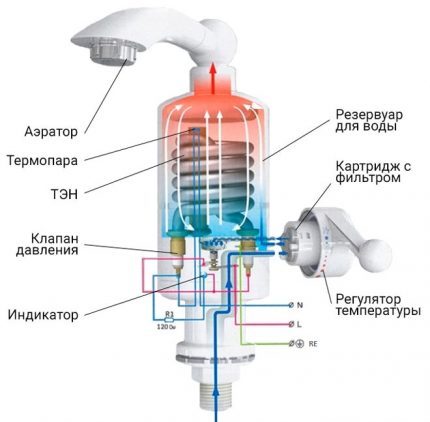
The heating tank has a small size, inside which a heating element or uninsulated spiral is installed for heating cold water. In a closed system, the heating elements do not directly come into contact with water, the flow passes through a copper or brass pipe, therefore such a heater has no problems with scale and the need for regular cleaning.
Devices with an open spiral consume energy by 15-20% more, but they also heat water much more efficiently.
But since their heating element is in water, it is advisable to install a filter system at the inlet. Although manufacturers claim that the device is designed so that during operation vibrations are created that do not allow scale to settle on spirals.
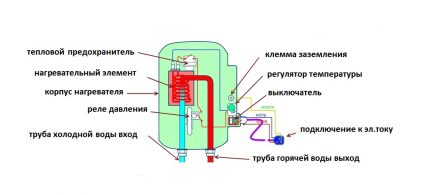
For safe operation, all devices are equipped with sensors that monitor the heating temperature, flow rate and, if necessary, stop the operation of the heating elements.
You can control the temperature of the water supply with a tap, increasing or decreasing the pressure. Most models are equipped with a mechanical switch, but there are also devices with the ability to program the temperature on the control unit.
Geysers and their nuances
Although the electric models of heaters are gaining market confidence, the pioneers of hot water supply are no less successful in operating - geysers. In these devices, cold water flows through a winding coil and is heated by the flame of a burner.
But the installation of gas heaters has a number of nuances. For their installation, it is necessary to obtain special permission from gas producers, equip the room with good ventilation and a chimney, where air with combustion products will be discharged.
In addition, for the column to work, a stable water pressure is needed, with a pressure of at least 0.25 atmospheres, otherwise the unit will simply not turn on.

Therefore, it is possible to install (or rather replace) a gas water heater only in houses in the design of which this equipment was already provided. And in new buildings it is better to give preference to safer electrical appliances, the installation of which is permissible in high-rise buildings.
Pros and cons of instantaneous heating
Devices that directly heat the stream can provide an unlimited resource of warm water without preheating and long waiting times.
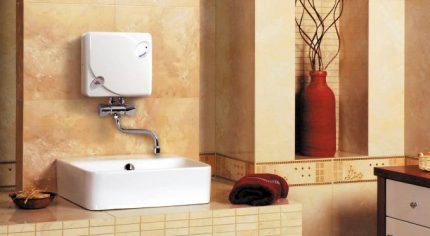
Other benefits:
- Compact models do not take up much space and can be hidden behind furniture facades or installed next to the sink to minimize heat loss.
- Do not consume energy when the tap is turned off, unlike boilers.
- Instantly heat water up to 35-60 degrees (depending on the power of the model and the temperature of the cold stream).
- They cost several times cheaper than storage units.
The disadvantages include the low pressure of the hot stream for low-power devices, because the water must have time to warm up while passing through a thin tube of the heat exchanger.
Also, electric heaters are demanding on wiring power, if you install a flow system to provide the whole house or several points, you need a 380 V line, an ordinary 220 V will not pull.
And another significant minus concerns inexpensive appliances with a fixed heating power - in cold and warm seasons, the water temperature can vary up to 20 degrees (and this at the same pressure).That is, in hot weather the water in the tap can reach 50 ° C, and in winter you have to take a shower at an invigorating 30-40 ° C.
Features of the storage boiler
The device itself is a capacious heat-insulated tank with pipes for supplying cold and hot water. A 1-2 kW heater, a temperature sensor and a magnesium anode protecting the device from scale are placed inside the tank.
There is another kind of storage devices - indirect heating boilers, where the role of the heating element is played by a coil heat exchanger connected to the heating circuit.
But this option is often chosen in addition to a single-circuit heating boiler to save energy in the cold season, and in summer it works on the principle of the same electric boiler (of course, provided that the heater is included in the package).
When turned on, the boiler draws water and heats it to the programmed temperature (for example, it will take about 2 hours to heat 100 l of heating elements by 2 kW to 60 degrees). When the water heats up, the thermostat trips and turns off the heating element.

Advantages of boilers:
- To connect, you do not need a powerful power line, even on standard 220 V the device will serve several mixers at the same time without problems.
- The ability to keep the temperature of the water in the tank for a long time (if there is a high-quality heat-insulating casing, the heating level will decrease no more than 1-2 ° C per hour).
- Able to immediately "issue" a large amount of water, for example, to quickly fill the bath.
- The temperature of the supplied water is always the same and will not depend on the time of year.
And the main disadvantages of the storage heater include a limited limit of hot water, a long waiting time for heating "from scratch" and the impressive dimensions of the tank (moreover, the more the family needs, the more bulky the device will be).
It should also be noted that if the device is not disconnected from the mains, it will consume energy even in standby mode, heating the water to the specified parameters when cooling.
Comparison of water heaters
Flowing and heating devices vary in size, price, appearance and energy consumption. Consider the most significant differences.
Parameter # 1 - weight and dimensions of units
In this category, the winners will undoubtedly be flow heating devices - they weigh no more than 2 kg and are compact in size. For example, to connect to a shower, a device 30 cm wide, 15-18 cm high and 10-11 cm thick is quite enough, which does not take up much space even in a standard booth.
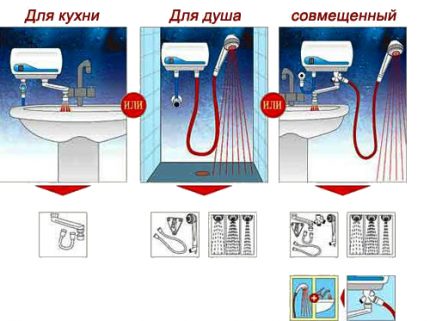
Although there are storage boilers the size of a soccer ball, their capacity is only 5-10 liters, which is clearly not enough even for the needs of one person.
Therefore, you will have to find a place on a round or rectangular unit with a size of at least 55x50x40 cm (and this is for a capacity of only 50 liters). Moreover, for wall mounting devices up to 120 liters are suitable, and more capacious models are designed for installation on the floor.
Parameter # 2 - the volume of the internal tank
The main criterion for the performance of the boiler is considered to be the volume of its internal tank, and the power of the heating element in factory products is already “tied” to the dimensions of the tank. Therefore, the size of the drive is selected solely according to the needs of the family.
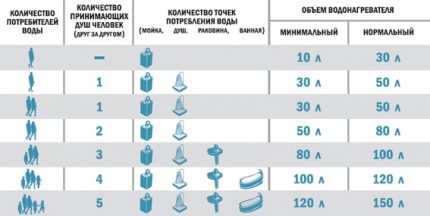
You can determine the required performance for an electric flow heater by the flow rate - the lower the power of the device, the thinner the trickle of hot water.
Recommended water velocity in pipes can be studied in SNiP 2.04.02-84, and calculate the comfortable one yourself, substituting a bucket under the shower head or faucet and measuring the amount of water leaked per minute.
The performance is calculated using the following formula:
V = 14.3 * (W / T2 - T1),
Where:
- V - maximum flow rate;
- W - heater power in kW;
- T2 - set temperature of water heating;
- T1 - water temperature in the water supply system - for winter it is about 0 ° C, for summer +15 ° C, but it all depends on the climatic features of your area.
But it is easier to trust the recommendations of the manufacturers by studying the instructions. It should indicate the scope of the product and how many liters in 1 minute the device can heat up.
For the arrangement of water points that do not require a large volume of water for a one-time intake, it is better to give preference to electric grooves, in the assortment of which there are models for showers and for mixers over the sink.
On average, a 5-8 kW heater will be needed for a shower, 3-3.5 kW will be enough for a faucet in the kitchen or a sink in the bathroom, and from 12 kW or more to supply several water outlets at once.
Parameter # 3 - cost-effectiveness and resource consumption
Many consumers do not even consider flowing heaters because of the high energy consumption.
But this is not entirely correct. If we recall at least a school course in physics, it becomes clear that for heating one liter of water you will need the same amount of energy, and it does not matter which device will heat it, flow or storage.
Therefore, the energy consumption will be greater electric boiler, because he spends a resource not only for heating water, but also for maintaining its temperature. For example, a device with polyurethane foam insulation with a thickness of 4-5 cm will consume 1-2 kW * h for protection against cooling.
A flow heater is more demanding on the power of the network, but it spends exactly as much electricity as is needed to deliver the requested amount of water.
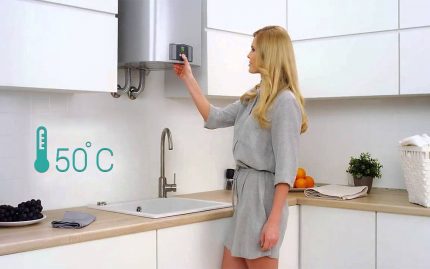
As for the cost of heating devices, the price of boilers is 2-3 times higher than the cost of purchasing a flow unit, although, of course, much depends on the model and its power. And in terms of prevention, flow systems hit the budget less - when you install a filter on the input, you will have to look inside the device no more than once in a couple of years of operation.
Care of the boiler requires regular cleaning of the calcareous stone of both the heating element itself and the inner walls of the tank and timely replacement of the rod of the magnesium anode.
If you neglect these recommendations, the device will constantly increase the time for heating and spend more and more energy, and will eventually fail. But even with good care, devices rarely “survive” for more than 10 years, but instantaneous heaters easily pass this mark.
Parameter # 4 - Installation and Connection Features
Installing a simple instantaneous water heater is quite simple, even if the repair in the apartment is already behind. The device has special mounts, for which it is easy to hang it on the wall (even drywall), like any hanging cabinet. Using a flexible hose, the entrance to the water supply system is connected, and the hot water outlet is connected to the mixer.
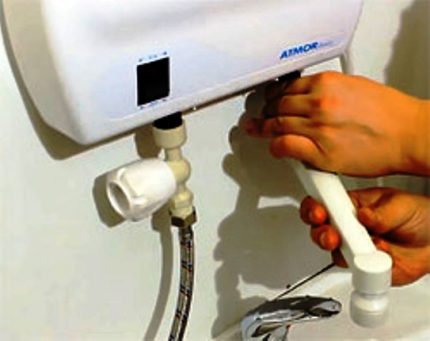
If we are talking about a powerful device designed for 5 or more kW, it is connected with a separate cable from the shield to the network with a voltage of 380 V.
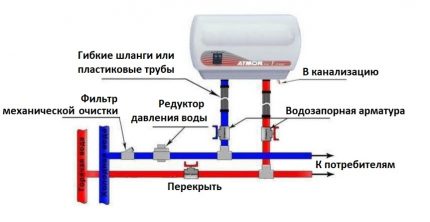
To fix the boiler in the wall, special anchors are installed on the dowels (diameter from 10 mm and length from 100 mm), on which the device is suspended.
Then pressure drops from the blocked water supply system, stop valves and tees cut into the pipes. In order to extend the “life” of the heating element, it is additionally recommended to insert filters of fine mechanical and deep cleaning at the inlet of cold water.
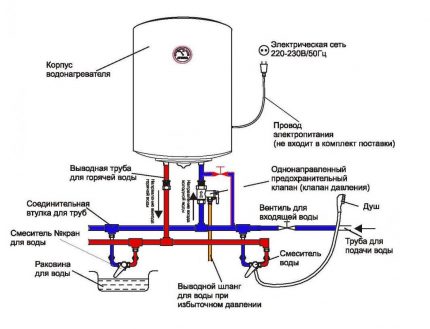
The boiler is connected via an RCD to a dedicated outlet with mandatory grounding. After connecting to the network on the device, the activity indicator will light up, after which you can program the temperature regime of water heating and test the operation of the device.
Which water heater to choose?
Although storage devices are more familiar and popular with consumers, before buying a heater, you should consider all the possibilities based on the number of people in the family, wiring power, house size and layout.
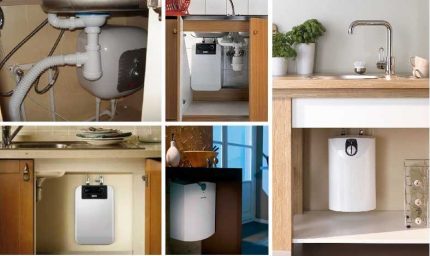
Several options to consider.
Option 1. If the power of the mains allows, you can install a flow heating device only for a shower. So you don’t have to wait a few hours to heat the storage tank, and there will be no situation when the last in line is not enough hot water.
A boiler is useful for filling the bath, washing dishes and other household needs. In addition, such a tandem will allow you to choose a smaller drive and save usable space.
Option # 2. The combination of heaters makes sense if the kitchen is located far from the bathroom or the location of the boiler. In this case, it is worth considering the possibility of installing a flow device on the sink tap.
Moreover, even if the electrical network in the house is standard, a small power device is quite enough for a kitchen mixer.
Option # 3. The installation of a floor-mounted boiler with a large volume will help solve the problem of hot water supply, when it is not possible to conduct a three-phase cable into the room.
Option # 4. For country houses with seasonal attendance is better install instantaneous water heater - then you don’t have to wait long for warm water, and in this case there isn’t much point in accumulating “reserves”.
Option # 5. If in a private house there is a gas or solid fuel boiler with one circuit, you can go to it connect indirect heating boiler and save on electricity in the winter.
The conclusion suggests itself: for small and irregular consumption, a flowing device is quite enough, for constant - it is better to choose a boiler.
But at high flow rates, you can consider combining heaters of various types or install a high-power flow system with a connection to a three-phase network.
Detail with selection arguments storage water heaters and flow equipment We will introduce articles recommended by us that contain a lot of useful information and recommendations.
Conclusions and useful video on the topic
To conduct a visual comparative analysis of water heating devices, study the video materials with the recommendations of the masters on the selection and installation of equipment.
Video # 1. About the device and design options for storage heaters:
Video # 2. Electric appliances of direct heating, principle of operation and varieties:
Video # 3. Criteria for choosing electric boilers and flow heaters:
As you can see, there is no definite answer to the question of what is best for the house - an accumulative or flow heater, because each device has its own characteristics and nuances.
But if you can’t decide for yourself, consult with plumbers who specialize in installing water heaters and installing plumbing systems. They will tell you exactly which option will be the “golden mean” for your home or apartment.
And what type of water heater do you prefer to install in your house / apartment? Tell us why your choice is justified, share your arguments with visitors to the site. Please write comments in the block below, ask questions, publish photos on the topic of the article.

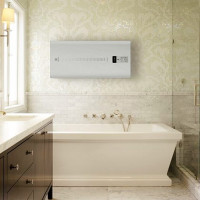 How to choose a storage water heater: which is better and why, what to look at before buying
How to choose a storage water heater: which is better and why, what to look at before buying 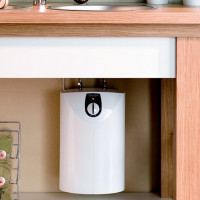 How to choose a flowing water heater: an overview of the types of “flowers” and tips for customers
How to choose a flowing water heater: an overview of the types of “flowers” and tips for customers 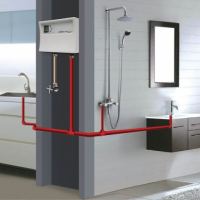 Instantaneous electric water heater for a shower: types, selection tips and an overview of the best manufacturers
Instantaneous electric water heater for a shower: types, selection tips and an overview of the best manufacturers 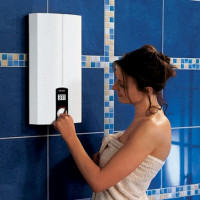 Which is better - a gas water heater or an electric water heater? Comparison of the main parameters
Which is better - a gas water heater or an electric water heater? Comparison of the main parameters 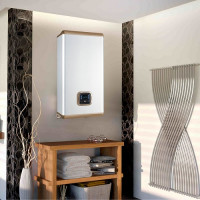 Which water heater to choose: determining the best equipment + model rating
Which water heater to choose: determining the best equipment + model rating 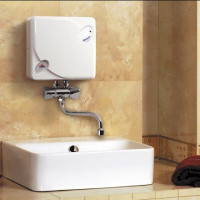 How to choose a water heater for an apartment and for a country house
How to choose a water heater for an apartment and for a country house  How much does it cost to connect gas to a private house: the price of organizing gas supply
How much does it cost to connect gas to a private house: the price of organizing gas supply  The best washing machines with dryer: model rating and customer tips
The best washing machines with dryer: model rating and customer tips  What is the color temperature of light and the nuances of choosing the temperature of the lamps to suit your needs
What is the color temperature of light and the nuances of choosing the temperature of the lamps to suit your needs  Replacement of a geyser in an apartment: replacement paperwork + basic norms and requirements
Replacement of a geyser in an apartment: replacement paperwork + basic norms and requirements
A few weeks ago in our family the question arose of moving to the parents, but since they live in a house without central water supply, I thought about solving this problem. There is a boiler in the shower room, but I want running hot water to flow from the tap in the kitchen. I’m very used to a city apartment with all amenities. Alas, the disadvantages are significant both in the accumulative system and in the flow system. Therefore, we still have a difficult choice, but I will take note of the good options proposed here.
Yes, the funded system has disadvantages, but it is still much better than a flow system. The groove has a thin head, it is very inconvenient. I once suffered with her. If there is free space, then it is definitely better to set the accumulative one.
We have a geyser for 15 years already. The hassle with it is a bit much - it often breaks, it is rather difficult to turn it on, and if you keep it on all the time, then the gas bill comes in space. But you can’t switch to electric either, because they often turn off the light. I myself watched with friends how the lights were cut off in winter, and then not only the water stopped heating, but the batteries began to cool. I want to buy a water heater that works both from gas and electricity.
The flowing heater is convenient only for washing dishes or taking a shower under a thin stream of water of 30-40 degrees. The article is good only the author hasn’t laid out all the numbers. I have a storage tank of 80 liters hanging on and I turn it on at night when the electricity costs several times less and then school physics will not help to calculate the benefit))) the price of the flowing liter and the storage))) only the size is favorable in flowing.
Hello. So many guns and spears are broken in comparisons. I chose by comparing similar power models of a groove and a drive. For the same price, I got half as much water in the groove, so it turns out if the boiler water is diluted to flow temperature.
In a large family, in an ordinary house, a boiler comes out more economically. But, for example, in the country house, it is better accumulative, since it is not necessary to drain the water upon departure, creating excess oxide and it is not necessary to warm the water for a long time, the water consumption there is usually minimal.
Also for those who live alone. And the price range is different everywhere, not in all settlements electricity is cheaper at night, in many the price is fixed per day / night.
Our family consists of three people, but the daughter pours water herself for three 🙂 The best is the boiler room, because there is always a supply of heated water, even when turned off. To save electricity, I put it at 60 degrees. It is not necessary to warm to 80 and maintain.